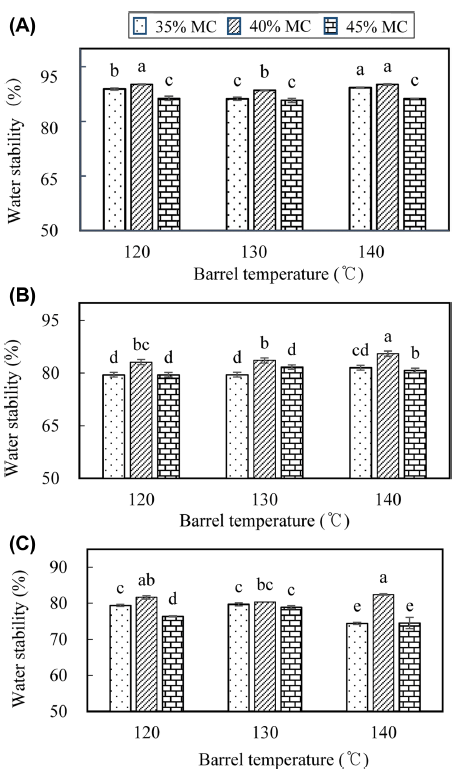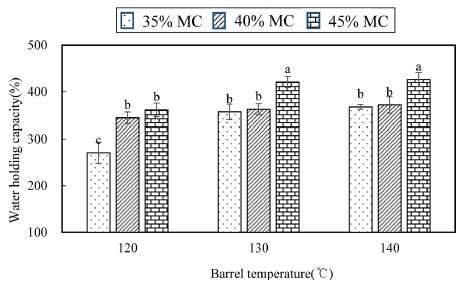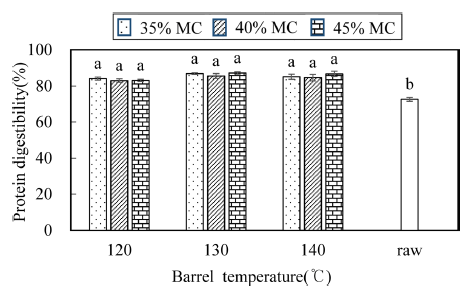Introduction
Aquaculture is one of the fastest growing food production activities in the world and also plays a very important role by providing better nutrition, a higher income, and better employment opportunities in many countries (Umar et al., 2013). In the past, fresh fish was used for fish feed (Yoshitomi, 2004). However, it was deemed to be expensive and nutritionally imbalance. Fish feed formulated from plant ingredients instead of fresh fish could be a solution to the problems of using conventional feeds.
Extrusion technology is commonly used to produce fish feed, as it exhibits improvement in physical properties, such as hardness and water stability (Harper, 1981; Sørensen et al., 2009). It is stated the extrusion cooking for aquaculture feed production is highly advantageous as it allows control over pellet density and greater water stability (Chang & Wang, 1999). Extrusion cooking is a high-temperature short-time process with combination of moisture and temperature which affects the nutritional value of fish diets (Shivendra et al., 2007; Morken et al., 2011). During extrusion processing, the different reactions take place including thermal treatment, starch gelatinization, protein denaturation, hydration, partial dehydration (Khater et al., 2014). Sørensen et al. (2009) reported that the improvement in digestibility is due to degradation of proteins during extrusion processing.
Yoshitomi (2004) studied the effect of barrel temperature on microstructure of extruded pellets. Umar et al. (2013) reported the effects of ingredients and extrusion variables on properties of aquafeeds containing distillers dried grains with soluble, corn starch and a combination of sago and tapioca starches. Sørensen et al. (2009) claimed that the soybean meal improves the physical quality of extruded fish feed. Therefore, the purpose of this experiment was to study the effects of barrel temperature and moisture content on the expansion, bulk density, hardness, water stability and water holding capacity, swelling ratio, protein and starch digestibility of extruded fish feed.
Materials and Methods
Fish meal and 3 grade wheat flour were purchased from SinSungonf Co. (Hoengseong, Korea). The defatted soy flour (50% protein content dry basis), fish oil, and others were obtained from Gaemifood Co. (Eumseong, Korea).
The mixture of fish meal 65%, 3 grade wheat flour 17%, defatted soy flour 10.7%, fish oil 5.8%, and others 1.5% was extruded with a co-rotating inter-meshing twin-screw extruder (THK 31T; Incheon Machinery, Incheon, Korea) with a screw length of 690 mm and a screw diameter of 30 mm (L/D = 23:1) (Fig. 1). The 4 mm die diameter was used. The barrel temperature was adjusted to 120, 130, and 140 ° C, moisture content was 35, 40 and 45%, and screw speed was 250 rpm. Extruded fish feed was dried at 50 ° C for 8 h and ground into powder to pass through a 50-70 mesh sieve. The dried fish feed was randomly chosen to analyze the physical properties and the powder for chemical analysis.
The expansion ratio was determined by the method of Khater et al. (2014). Ten samples were randomly selected and their diameters were measured. The expansion ratio was calculated using the below equation
Bulk density was reported as the weight of extruded fish feed divided by the volume of fish feed (Umar et al., 2013). The pellets were poured into a known volume cylinder to measure the weight of the pellets. Measurements were conducted in triplicate.
Hardness was determined using a texture analyzer (Compac- 100II, Sun Sci. Co., Tokyo, Japan) equipped with a 10-kg load cell. The pellets are measured individually between a flattedended cylindrical probe at a speed of 100 mm/min. Hardness was averaged from 10 pellets and reported as force (g) divided by area (cm 2 ).
Samples (10 g, wet basis) and 500 mL of tap water were placed into 1,000 mL of soluble extraction bath (TW-SM, Wooju Scientific Co., Pohang, Korea). Each sample was stirred in the soluble extraction bath at room temperature and was shaken at 100 rpm for 1, 2 and 3 h. The sample was filtered by 20 mesh screens, and dried at 105 ° C until equilibrium was reached. The water stability was calculated by using the following formula.
Water holding capacity of pellet samples was analyzed using the method of Yoshitomi (2004). Ten pellets of each sample were mixed with distilled water in a beaker at room temperature for 1 h. The soaked pellets were filtered through a 20 mesh screen and were drained for 5 min before weight. The water holding capacity was calculated by following the equation.
Swelling ratio followed the method of water holding capacity. The diameter was determined before soaking and after soaking. The swelling ratio was obtained by using the following equation.
The protein digestibility (PD) was determined by slightly modified method of Thin et al. (2016). For the undigested protein content, 0.2 g powder was mixed with 35 mL pepsin solution in micro tube (1.5 g pepsin/1,000 mL of 0.084 N HCl). The mixture was digested at 37 ° C for 2 h at 150 rpm in a shaker (SI-300R, Jeio Tech Co., Ltd., Seoul, Korea). Then, 2 mL of 2 M NaOH was added to stop reaction. The reacted solutions were centrifuged at 3000 rpm for 15 min. The residues were dried at 50 ° C for 12 h. The sediments were used to analyze the protein content with Ninhydrin method by using albumin protein as a standard (Starcher, 2001). For the determination of total protein content of the sample, 10 mg was hydrated with 6 N HCl solution of 500 μL at 100 ° C for 24 h. The hydrated sample was redissolved in 1.4 mL distilled water and centrifuged at 3000 rpm for 30 min. After centrifugation, the supernatant was collected for analyzing total protein content. The PD was expressed by following equation:
Results and Discussion
The expansion produced by the extrusion process is created when moisture trapped within the mixture vaporize into steam as materials exit the die (Vijayagopal, 2004). The expansion ratio of extrudates was shown in Table 1. The values on expansion ratio of fish feed ranged from 0.99 to 1.14. The expansion ratio decreased with increased moisture content while barrel temperature did not show significant effect on the expansion ratio. The decreased expansion ratio trend with increasing moisture content was also reported by Ryu & Ng (2001) and Chang & Ng (2011). This decrease in expansion ratio was probably due to excessive structure breakdown and the greater fragmentation of starch at higher moisture. The fluidity of material was limited by lower moisture content during extrusion process, resulting in higher shear and longer residence time, which increase the expansion (Harper, 1981). In addition, the decrease in expansion may also be due to the increase in longitudinal expansion due to high temperature in the axial direction (Thin et al., 2016).
Rokey & Huber (1994) suggested a bulk density of 320-400 g/L for floating feed and 450-550 g/L for sinking feed. There was a negative correlation between bulk density and expansion ratio which describes the degree of puffing in extrudates. The bulk density significantly decreased when moisture content was increased from 35% to 45% (Table 1). At 35% moisture content, a significant reduction was observed when the barrel temperature increased from 120 ° C to 130 ° C, but significant increase was observed with further increase of temperature from 130 ° C to 140 ° C. At 40% moisture content, an increase in processing temperature decreased bulk density of extruded fish feed. Case et al. (1992) reported that an increase in the processing temperature resulted in decreased unit density values. At 45% moisture content, the values of bulk density increased from 275.26 to 367.26 g/L, and then decreased to 334.71 g/L with increasing temperature (Table 1). The highest bulk density value was observed for the treatment combination of 120 ° C barrel temperature, 35% moisture content, which was 463.89 g/L (Table 1). Kannadhason & Muthukumarappan (2010) reported that increasing the expansion of an extruded diet which causes a decrease in bulk density of the extruded diet. High bulk density improves the handling in feeding equipment, compared to lower bulk density (Dozier, 2001).
Hardness should be high in order to make the pellet withstand a certain amount of force without cracking for instance when feed is stored in bins. However, no standards were established for hardness (Khater et al., 2014). Hardness might affect voluntarily feed intake. If the feed is too hard, the utilization of nutrients might be lower, on the other hand, too soft pellets may cause problems associated with the logistics. The data of hardness was shown in Table 1. It is indicated that the hardness increased with increasing the moisture content. The values of hardness increased firstly, and then decreased with increasing the barrel temperature at 35% of moisture content; however, the values of hardness decreased with increasing the barrel temperature at 40% and 45% of moisture content.
Bandyopadhyay & Rout (2001) reported that the water stability of feed plays an important role in determining the overall performance of the feed. For instance, nutrient was leached by the disintegration of extruded pellets. Eugenio (2005) describes that water stability should decrease with the increase in protein content. With increasing soaking time from 1 h to 3 h, decrease in water stability was observed (Fig. 2). Water stability significantly increased with increasing moisture content from 35% to 40%, but it significantly decreased when the moisture content was further increased from 40% to 45%. The highest value can be found at 140 ° C barrel temperature and 40% moisture content with soaking time 1 h. Umar et al. (2013) also reported similar results that varied from 87.2% to 90.8%. The degree of stability of feed is believed to be almost directly related to the extent of gelatinization (Stivers, 1971).

Water holding capacity is an important property reflecting the protein-water interaction and can affect sensory attributes of protein products (He et al., 2014). The water holding capacity of the extruded fish feed was shown in Fig. 3. The water holding capacity of the samples ranged from 325.20% to 443.13%. At barrel temperature of 120 ° C, the sample with water holding capacity of 35% moisture content was significantly higher than with moisture content of 40% and 45%. However, there was no significant difference between samples with moisture content of 40% and 45%. At barrel temperature of 130 ° C and 140 ° C, the water holding capacity was similar between samples that have moisture content of 35% and 40%, but significant increase in water holding capacity was detected when moisture content of the sample increased from 40% to 45%. The samples with moisture content of 35% and 45%, showed significant increase in water holding capacity when barrel temperature increased from 120 ° C to 130 ° C. Moisture content had no effect on water holding capacity at 130 ° C, which was in line with the description of He et al. (2014). The highest water holding capacity was measured with the value of 426.25%, when barrel temperature was 140 ° C and moisture content was 45%.

Swelling ratio is an important properties of fish feed. The swelling ratio of extruded fish feed ranged from 1.31 to 1.45 (Fig. 4). The swelling ratio significantly decreased with increasing moisture content. At the same moisture content, the degree of reduction of swelling ratio was shown to increase with the rise in barrel temperature from 120 ° C to 130 ° C and further increase from 130 ° C to 140 ° C promoted a significant reduction in swelling ratio (Fig. 4).

Protein digestibility (PD) refers to the percentage of proteins that are absorbed in the digestive tract. A protein with high digestibility has better nutritional value than the one with low digestibility because it would provide more amino acids for absorption by proteolysis (Starcher, 2001). As observed in Fig. 5, it is indicated that extrusion improves protein digestibility significantly. Shivengra et al. (2007) also reported that protein digestibility value of extrudates was higher than that of one non-extruded product. However, the protein digestibility values of extruded fish feed was not as significantly different between samples with different moisture content and processing temperature (Fig. 5). Protein digestibility values varied from 82.97% to 87.21%. This might be due to the fact that the extrusion parameters not high enough to affect protein digestibility of fish feed. Sørensen et al. (2002) and Sørensen et al. (2005) also reported that the parameters of fishmealbased diet extruded with twin-screw extruder and single screw extruder at different temperatures (100 to 150 ° C) did not affect protein digestibility.

Conclusion
In this study, nine different types of extruded fish feed pellets underwent different barrel temperature and moisture content on physicochemical properties of extruded fish feed were investigated. Moisture content had negative influence on expansion ratio and bulk density. Hardness showed negative effect with expansion ratio. Both of barrel temperature and moisture content had positive effect on water holding capacity. Protein digestibility significantly increased after extrusion. Hence, from this study, it has been found out that pellet quality could be improved through extrusion process.









